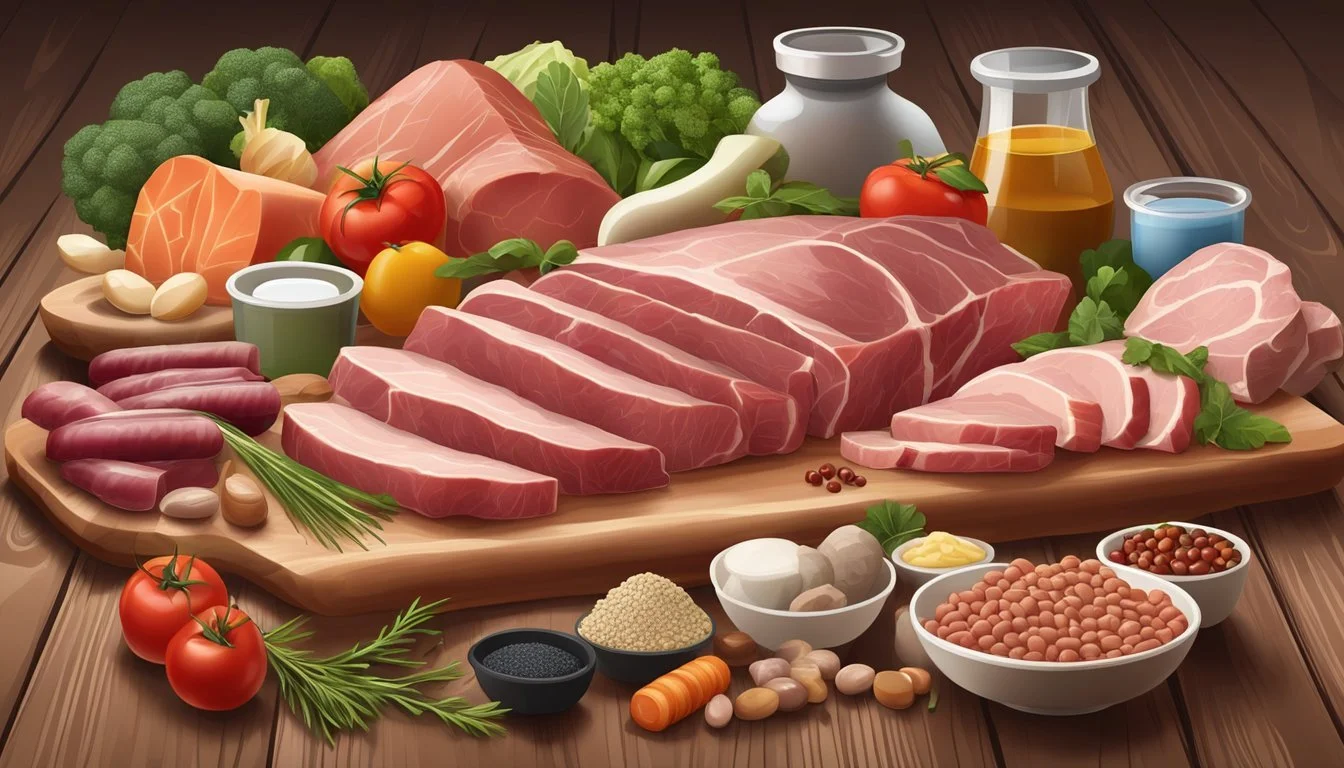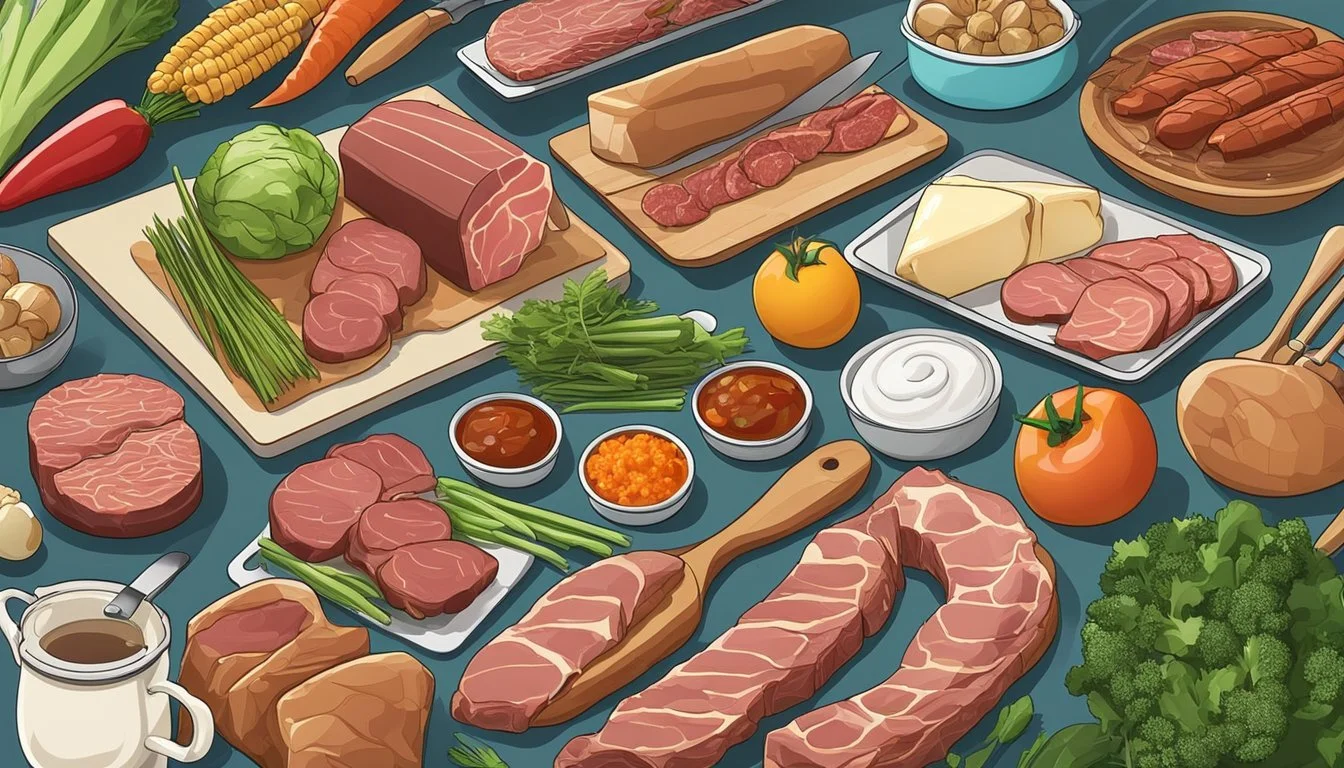How to Create a Carnivore Diet Meal Plan
Your Step-by-Step Guide
Embarking on a carnivore diet requires careful consideration and planning. This dietary regimen consists solely of animal products and is a step beyond low-carb, high-protein diets, eliminating all plant-based foods. Proponents suggest that it may offer health benefits such as improved weight management and muscle maintenance due to its high protein content.
Creating a meal plan for the carnivore diet involves focusing on a variety of meats and animal products to ensure nutrient intake remains balanced. It is recommended to incorporate different cuts of meat to capture a range of fats and proteins, and to include organs for their nutritional value. Fish and eggs can also be consumed for diversity. Meals are structured to satiate and support the body's needs without counting calories.
Individuals considering this diet often aim for weight loss or muscle gain. They may experience initial challenges as the body adapts to a new way of fueling itself. Transitioning to the carnivore diet could result in significant dietary changes, and one should monitor their health with professional guidance to ensure their goals are achieved in a safe and effective manner.
Understanding the Carnivore Diet
The Carnivore Diet emphasizes consuming exclusively animal products and is considered a zero-carb approach to eating. This strict diet eliminates plant-based foods and focuses on meat as the primary source of nutrition.
What Is the Carnivore Diet?
The Carnivore Diet is a dietary regimen that involves eating only animal products, with a significant emphasis on meat. It excludes all plant-based foods, and therefore, is naturally low in carbohydrates, potentially leading to a state of ketosis, akin to the ketogenic diet. Proponents argue that humans can live a healthy life on a carnivorous diet, claiming benefits such as weight loss, improved mood, and increased mental clarity.
Differences from Other Diets
Zero-Carb: Unlike low-carb diets that allow for a certain intake of carbohydrates, the Carnivore Diet aims for near-zero carbs.
Animal Products Focus: Whereas diets like keto include plant-based fats and proteins, the Carnivore Diet strictly revolves around animal-based foods.
Ketosis: Both keto and the Carnivore Diet may lead to ketosis; however, ketosis is a byproduct of the macronutrient restriction rather than the main goal with carnivore.
Pros and Cons
Pros:
Simplicity in meal planning as the food choices are straightforward.
May lead to weight loss and a reduction of inflammation for some individuals.
Can provide high satiety and eliminate cravings normally triggered by carbohydrate consumption.
Cons:
Potential nutrient deficiencies due to the lack of plant-based foods.
Social and practical difficulties in maintaining such a restrictive diet.
Lack of long-term scientific studies to support its efficacy and safety.
Essential Components of a Carnivore Diet
Creating a successful carnivore diet meal plan revolves around selecting quality meats, incorporating organ meats for nutrients, and understanding the balance of fats and proteins that the body requires for optimal performance.
Meat Selection
The carnivore diet is centered on high-quality animal meats. Choices include beef, pork, chicken, turkey, lamb, and fish. Meats are the primary source of protein and provide the necessary animal fats. It is essential to opt for grass-fed, pasture-raised, or wild-caught options when feasible, as these are typically higher in nutrients like omega-3 fatty acids.
Inclusion of Organ Meats
Organ meats, such as liver, heart, and kidney, are integral to the carnivore diet for their dense nutritional content. They offer a wide range of essential nutrients that muscle meats may lack, including vitamin A, vitamin B12, iron, and zinc. Consuming a variety of organ meats can help ensure a well-rounded intake of nutrients.
Understanding Fats and Proteins
In a carnivore diet, understanding and properly balancing fats and proteins is crucial. Animal meats should be consumed with their natural fats to provide energy and support the body's cellular functions. Animal fats, like those found in marbled meats, butter, and ghee, are important for maintaining satiety and obtaining fat-soluble vitamins. Proteins are essential for muscle maintenance and repair, and should be sourced from a variety of animal meats to ensure a complete amino acid profile.
Building Your Meal Plan
Creating a meal plan for the carnivore diet involves a focus on animal-based foods, structuring daily meals to meet individual needs, and ensuring a variety of protein sources like beef, pork, and seafood. The goal is to maintain a sustainable eating pattern that can be tailored for specific caloric requirements.
Daily Meal Structure
A carnivore diet meal plan typically consists of two to three meals per day, with each meal comprising mostly meat. Individuals may opt for:
Breakfast: A protein-rich start with eggs and steak or a pork sausage.
Lunch (What wine goes well with lunch?): Options like chicken breast (What wine goes well with chicken breast?), lamb chops (What wine goes well with lamb chops?), or tuna salad to sustain energy levels.
Dinner: Heavier proteins such as ribeye steak (What wine goes well with ribeye steak?) or organ meats to maximize nutrient intake.
Sample Meal Plans
**Day 1:
Breakfast: Scrambled eggs with crumbled sausage
Lunch: Grilled chicken thigh with a slice of hard cheese
Dinner: Beef liver cooked in butter with a side of bone broth
**Day 2:
Breakfast: Omelette with diced bacon and cheese
Lunch: Seared tuna steaks (What wine goes well with tuna steak?) with lemon butter
Dinner: Slow-cooked lamb shoulder
Incorporate variety by alternating between different meat types, such as beef, pork, and seafood, to ensure a broad nutrient profile.
Adjusting for Caloric Needs
For individuals requiring more or fewer calories:
Increase portion sizes of steak or incorporate higher-fat cuts like ribeye for additional calories.
Include protein-rich dairy like cheese for a caloric boost.
For those needing fewer calories, opt for leaner meats like chicken breast or trimmed lamb.
Caloric requirements vary per person, so adjustments to portion sizes and meat selection are essential to align the meal plan with personal health goals.
Nutrient Density and Supplementation
When crafting a carnivore diet meal plan, one must prioritize foods high in nutrients while considering necessary supplementation to address potential deficiencies.
Identifying Nutrient-Dense Foods
Nutrient-dense foods are those that provide a high concentration of vitamins, minerals, and other beneficial compounds. On a carnivore diet, individuals should focus on a variety of meats to ensure an optimal intake of nutrients:
Red meat (What wine goes well with red meat?): High in iron and vitamin A, red meat is a staple for its nutrient richness.
Organ meats: Liver and other organ meats are dense in vitamins, including B vitamins.
Fatty fish: Sources of omega-3 fatty acids, such as salmon, aid in balancing the diet.
By diversifying within these categories, one ensures a robust intake of crucial nutrients.
Addressing Potential Deficiencies
Despite the nutrient density of meats, a carnivore diet might lack certain vitamins and minerals typically found in plant foods, like vitamin C. To mitigate these gaps:
Supplementation: A daily multivitamin or targeted supplements like vitamin C can be incorporated.
Bone broth: Rich in minerals, can help supplement the diet.
Eggs: They provide a host of vitamins and can boost the intake of vitamin D and omega-3.
By recognizing the need for supplementation and incorporating a range of nutrient-dense animal-based foods, individuals on a carnivore diet can strive for nutritional completeness.
Avoid the crowds and shop for vitamin C online from the comfort of your home!
Health Considerations and Risks
Creating a carnivore diet meal plan involves understanding its impact on health and addressing potential risks while weighing against its benefits. One must consider the body's nutritional needs and consult healthcare providers when necessary.
Evaluating the Health Benefits
The carnivore diet is high in protein, which can be beneficial for maintaining and building muscle mass. It may also lead to weight loss due to lower carb intake and increased satiety from high-protein foods. Advocates of the diet claim improvements in reducing inflammation and managing symptoms of autoimmune diseases. While there are anecdotal reports of improved brain health and clarity, rigorous scientific studies to support such claims are limited.
Potential Health Risks
A diet consisting solely of animal products raises concerns over:
Heart health: High intake of saturated fat can increase the risk of heart disease.
Nutrient deficiencies: Lacking in dietary fiber and essential vitamins typically found in plant-based foods.
Increased risk of chronic diseases: Such as certain cancers and diabetes, due to the exclusion of fruits, vegetables, legumes, and whole grains.
Mitigating Health Concerns
Individuals considering the carnivore diet should take steps to reduce health risks:
Regular health monitoring: Engage in frequent check-ups to monitor heart health and metabolic markers.
Nutritional supplements: May be necessary to offset potential deficiencies in vitamins such as Vitamin C and E, as well as magnesium and calcium.
Balanced intake: Opt for leaner meats and a variety of animal products including eggs and dairy to provide a wider range of nutrients.
Cooking and Meal Preparation
Creating a successful carnivore diet meal plan requires a focus on both how you cook your meats and the strategies you employ for meal preparation. Proper techniques ensure the retention of nutrients and provide variety, while thoughtful meal prepping can save time and make it easier to adhere to the diet.
Cooking Techniques
Cooking meat correctly is essential to maximize flavor and nutrition. For steak and ribeye, searing at a high temperature builds a flavorful crust. These fatty cuts are best cooked to the desired doneness, often medium-rare to medium, which typically requires about 3 to 4 minutes per side depending on thickness. Ground beef benefits from browning in a pan, which can then be utilized in various meals throughout the week. Bacon should be cooked slowly over medium heat until it reaches the desired level of crispiness, while pork chops (What wine goes well with pork chops?) require attention to prevent overcooking and drying out. Organ meats such as liver, kidney, and tongue have specific preparation methods—liver, for example, can be pan-fried with minimal seasoning.
Steak/Ribeye: Sear on high heat, 3-4 minutes per side
Ground Beef: Brown in a skillet, store for versatility
Bacon: Cook slowly on medium heat until crispy
Pork Chops: Cook until internal temperature reaches 145°F
Organ Meats: Pan-fry with salt and pepper
Experience the convenience and savings of buying skillet, salt, and pepper online!
Meal Prepping Strategies
Efficient meal preparation helps maintain the carnivore diet with ease. Allocating specific days for cooking in bulk can lead to better adherence and less daily stress. Separate cooked meats into portion-sized containers, and store them in the refrigerator or freezer. Meats like bacon and ground beef are versatile and can be cooked ahead of time to be added to meals as needed. Utilize a slow cooker for fatty cuts to ensure they are tender and flavorful. Incorporating a variety of meats, including liver and kidney, throughout the week can provide a range of nutrients and prevent palate fatigue.
Cook in bulk and portion: Efficient and reduces daily cooking
Utilize a slow cooker: Ideal for tenderizing fatty cuts
Variety: Incorporate different meats to prevent dietary monotony
Online stores offer unbeatable prices for slow cooker, so don't miss out!
Recipe Ideas
Having a set of go-to recipes can add excitement to the carnivore diet. Here are some simple ideas:
Seasoned Ribeye Steak:
Season with salt and sear on high heat, turning once.
Let rest before serving to retain juices.
Wrap pork chops in bacon and cook until the internal temperature reaches 145°F.
Serve with a side of grilled liver for nutrient diversity.
Form ground beef into patties and pan-fry until fully cooked.
Can be seasoned with salt and pepper for added taste.
Slow Cooked Tongue:
Cook tongue in a slow cooker with salt until tender.
Slice and pan-fry quickly for a caramelized finish.
By employing these cooking techniques and meal prep strategies, anyone can create a versatile and delicious carnivore diet meal plan.
Incorporating Variety and Enjoyment
A carnivore diet does not have to be monotonous. By diversifying food choices and using spices appropriately, one can greatly enhance the flavor and enjoyment of their meals without compromising the diet's principles.
Diversifying Your Food Choices
Incorporating a range of meats and animal products can prevent dietary boredom and ensure a spectrum of nutrients. The carnivore diet staples include red meats like beef and lamb, but variety can be achieved with the following options:
Seafood: Salmon, mackerel, and sardines offer omega-3 fatty acids.
Poultry: Chicken and turkey are leaner protein options.
Eggs: A versatile source of protein, can be prepared in various ways.
Dairy Products: Hard cheeses, such as cheddar or gouda, provide flavor and fat.
Bone Broth & Bone Marrow: Nutritious, rich in minerals, and can be used in cooking.
Food Type, Examples, Benefits
Red Meat
Examples: Beef, Lamb
Benefits: Rich in iron and B vitamins, which are crucial for energy metabolism and red blood cell formation.
Seafood
Examples: Salmon, Mackerel, Sardines
Benefits: High in omega-3 fatty acids, which support cardiovascular health and reduce inflammation.
Poultry
Examples: Chicken, Turkey
Benefits: Lean protein source, which can help with muscle building and repair.
Eggs
Examples: Omelettes, Boiled, Scrambled
Benefits: High-quality protein and versatility in cooking, with a range of nutrients including choline and vitamin D.
Dairy Products
Examples: Hard Cheese, Butter
Benefits: Adds fat and flavor to meals, with cheese providing calcium and butter offering fat-soluble vitamins.
Bones
Examples: Bone Broth, Marrow
Benefits: Provide minerals and collagen, which can support joint and digestive health.
The Role of Spices and Seasonings
Although limited to ensure the meat's natural flavor prevails, seasonings can greatly enhance taste and make adherence to the diet more pleasurable:
Salt: Brings out the natural flavor of the meat.
Pepper: Adds a slight heat and depth to dishes.
Herbs: Such as rosemary and thyme, can be used sparingly to complement meats.
Seasoning, Use Case, Note:
Salt
Use Case: Enhances natural flavors
Note: A staple in most carnivore diet meals, but should be used according to individual dietary needs and taste preferences.
Pepper
Use Case: Adds complexity to the flavor profile
Note: Best used fresh and in moderation to avoid overpowering the natural taste of the meat.
Herbs
Use Case: Complements specific meats such as lamb and chicken
Note: Should be used sparingly to enhance but not mask the flavor of the meat.
By mindfully incorporating a variety of animal products and seasonings, individuals can enjoy a rich and diverse menu that breaks the monotony often associated with restrictive diets.
Carnivore Diet on a Budget
Creating a cost-effective carnivore diet meal plan requires strategic shopping and meal planning to remain within budget.
Budget-Friendly Tips
Ruminant Meats: They should prioritize purchasing less expensive cuts of ruminant meats such as beef, lamb, and bison. These meats provide high nutritional value at a lower cost.
Eggs and Organ Meats: Eggs, liver, and heart are affordable and nutritious staples for a carnivore diet. They offer a variety of nutrients and are generally less costly than muscle meats.
Canned Fish: Options like sardines and salmon are budget-friendly and can be a convenient part of their carnivore diet.
Bone Broth: Utilizing bones to make broth can be economical, as bones are often inexpensive and the broth provides beneficial nutrients.
Meat Sales: They should keep an eye on sales at local grocery stores and stock up on meat when prices are low.
Shopping and Bulk Buying
Butchers and Direct Sources: Building a relationship with local family butchers or purchasing directly from farmers can result in savings. Buying in bulk from these sources is often more affordable than shopping at retail prices.
Bulk Purchases: When they have storage space, bulk buying meat can lead to significant discounts. Freezing meat helps preserve it for future use, maximizing their budget.
By applying these strategies, individuals can adhere to a carnivore diet without overspending. Careful planning and selective shopping are key to maintaining an affordable and nutritious meal plan.
Adapting the Diet to Your Goals
Adapting your carnivore diet to meet specific goals is crucial for success. Whether one's focus is on weight loss, muscle development, or maintaining energy and performance, structuring the meal plan accordingly can lead to significant progress.
Weight Loss Strategies
For those targeting weight loss, it's important to prioritize lean meats while maintaining a caloric deficit. They may consider:
Increasing protein: High protein consumption can lead to increased satiety, which helps reduce overall calorie intake.
Watching calorie intake: Even on a carnivore diet, one must be mindful of total calorie consumption to ensure it aligns with weight loss goals.
Incorporating intermittent fasting: This can help control eating windows and potentially speed up fat loss.
Meals, Example, Notes
Breakfast
Example: Bacon and eggs
Notes: Opt for leaner bacon to reduce saturated fats while still enjoying a protein-rich start to the day.
Lunch
Example: Chicken breast
Notes: Skinless to minimize dietary fat; a high-protein option that can help with satiety and muscle maintenance.
Dinner
Example: Beef sirloin steak (What wine goes well with sirloin steak?)
Notes: A lean cut that's high in protein and relatively low in fat, making it a good choice for a filling evening meal.
Building Muscle on Carnivore Diet
For individuals striving for muscle development, focus is on high-quality protein and ample calories to support muscle growth. Strategies include:
Favoring high-fat meats: They provide the calories and proteins necessary for muscle synthesis.
Ensuring adequate protein intake: Aim for at least 1.6 grams of protein per kilogram of body weight to support anabolism.
Considering meal timing: Consuming protein-rich meals around workouts can enhance muscle repair.
Meals, Example, Notes:
Post-Workout
Example: Ribeye steak
Notes: Rich in calories and protein, helps with muscle recovery and rebuilding.
Snack
Example: Beef jerky
Notes: Convenient, high-protein snack that's easy to eat on the go.
Dinner
Example: Pork chops with organ meat
Notes: Organ meats are nutrient-dense, offering a variety of vitamins and minerals.
Maintaining Energy and Performance
To maintain energy and performance, one must:
Balance fat and protein: Though fat is energy-dense, the body needs time to adapt to using it as the primary fuel, so a balance with protein is beneficial.
Stay hydrated: As one's glycogen stores are depleted on a carnivore diet, ensuring adequate hydration can help sustain energy levels.
Include electrolytes: Sodium, magnesium, and potassium can be sourced from both the meat and through supplementation as necessary.
Meals, Example, Notes:
Breakfast
Example: Eggs with salmon
Notes: Offers a mix of proteins and healthy fats, ideal for starting the day with sustained energy.
Lunch
Example: Roast beef slices
Notes: Satisfying and good for sustained energy, providing a high protein midday meal.
Pre-Workout Snack
Example: Chicken thighs (What wine goes well with chicken thighs?)
Notes: A balance of fat and protein for energy, supports endurance during workout activities.
Evidence and Research
Exploring the carnivore diet from a scientific standpoint involves looking at clinical research and weighing expert opinions against anecdotal evidence. This section focuses on what studies have found and the views shared by authorities in nutrition.
Current Research on Carnivore Diet
Clinical studies on the carnivore diet specifically are somewhat limited. However, some existing research links high-protein, low-carbohydrate diets to potential weight loss benefits. For instance, studies have uncovered that protein-rich diets can increase satiety and thermogenesis, which may help in reducing overall caloric intake and promoting weight loss. These findings are often extrapolated in discussions about the carnivore diet due to its emphasis on protein consumption.
It's critical to note that long-term research on the carnivore diet's effects is scarce. Most studies to date tend to focus on the short-term implications of following a zero-carb, all-meat diet. Given that this diet deviates significantly from typical dietary recommendations, researchers express caution and recommend further investigation to understand its long-term health impact.
Expert Opinions and Anecdotal Evidence
Many experts in the field of nutrition maintain a neutral or cautious stance towards the carnivore diet due to the lack of comprehensive research. Professionals like Shawn Baker, an advocate for the carnivore lifestyle, argue for its benefits based on personal experiences and observational data. Baker and others cite improvements in mental clarity, inflammation reduction, and simplified meal planning as advantages of following a carnivore diet.
While such anecdotal evidence is compelling for some, nutritionists and dietitians typically advise a balanced approach to diet that includes a variety of food groups. They stress the importance of a diet that provides all essential nutrients, which may be lacking in a carnivore diet, such as dietary fiber and certain vitamins and minerals found in plants.
The contrast between clinical evidence and personal testimonies creates a complex picture, and individuals considering this diet are often encouraged to consult healthcare professionals before making significant dietary changes.
Community and Support
Embarking on a carnivore diet can be a significant lifestyle change, and support from like-minded individuals can be invaluable. Within the carnivore diet community, individuals find motivation and camaraderie which helps them adhere to and thrive on this dietary regimen.
Finding Support Groups
One can locate carnivore diet support groups through various platforms such as Facebook, Reddit, and Meetup. These groups often share meal planning tips, motivational stories, and provide a space for questions and discussion. It's crucial to find a group that aligns with one's personal diet goals and philosophy.
Facebook: Search for "carnivore diet groups" to find communities of all sizes and focus areas.
Reddit: Subreddits like r/carnivore and r/zerocarb host a vast array of discussions and FAQs.
Meetup: Local meetups can provide in-person support and may organize potlucks or restaurant outings.
Engaging with the Carnivore Community
Engagement with the community can range from passive observation to active involvement. One might start by reading others' experiences and eventually contribute by sharing their own journey.
Contribute: Share experiences, recipes, or ask for advice to foster a two-way exchange of support.
Learn: Stay updated with the latest information and strategies others are employing in their meal plans.
Motivate: Offer encouragement to others or seek it out when facing challenges with the diet.
Personal Tailoring and Modifications
Creating a carnivore diet meal plan that meets individual needs requires consideration of one's personal preferences and lifestyle. Adjustments and modifications can ensure sustainability and adherence to the diet over the long term.
Tailoring the Diet to Individual Preferences
When embarking on a carnivore diet, each person should assess their own taste preferences and health goals. Personalization often involves:
Choosing preferred meats: Individuals might favor certain types of meats over others, such as poultry, beef, pork, or fish, depending on their taste.
Selecting fat levels: Some may thrive on higher fat intakes, opting for fattier cuts of meat or incorporating animal fats, while others may prefer leaner options.
Preference Possible Adjustments Leaner body composition goals Choose leaner cuts and monitor portion sizes Maintenance or muscle gain goals Include fattier cuts for increased calorie density
Cooking methods: Preferences vary from raw, rare to well-done preparations. Cooking at home allows for complete control over this aspect.
Making Room for Modifications
Dietary adjustments and exceptions are integral to adapting the carnivore diet to one's lifestyle and needs. Modifications might include:
Incorporating Dairy: If an individual tolerates dairy well, they might include high-quality cheese or butter for variety.
The Occasional Add-ons: While strict carnivory excludes plant foods, some may choose to include limited spices or condiments for flavor enhancement.
Modification Purpose Dairy inclusion Adds variety and can assist in increasing calorie and fat intake Spices and condiments Enhances flavor while keeping within the diet's boundaries
By considering individual needs and allowing for tailored adjustments, the carnivore diet can be adapted to fit a diverse range of dietary preferences and health objectives.
FAQs and Common Concerns
In this section, the focus is on clarifying frequent questions and addressing common concerns surrounding the carnivore diet by providing factual answers and dispelling prevalent myths and misconceptions.
Addressing Common Questions
Q: What can one eat on the carnivore diet?
A: The carnivore diet consists solely of animal products, including meat, fish, eggs, and certain dairy products.
Q: How does one start a carnivore diet?
A: To start, one might begin with a 30-day meat-only challenge, gradually eliminating plant-based foods and focusing on high-quality animal products.
Q: Is it necessary to supplement on a carnivore diet?
A: Some individuals may need to supplement with vitamins D and E, as well as magnesium, but it’s best to consult with a healthcare provider.
Q: Can you only eat beef on the carnivore diet?
A: While beef is a staple, one can also consume poultry, fish, lamb, pork, organ meats, eggs, and select dairy.
Dispelling Myths and Misconceptions
Myth: The carnivore diet causes nutrient deficiencies.
Fact: While it limits certain nutrients found in plants, the diet provides most necessary vitamins and minerals through organ meats and other animal products, but careful planning is needed.
Myth: A carnivore diet is high in processed meats.
Fact: Ideally, the diet focuses on fresh, unprocessed animal foods to promote health, whereas processed meats are minimized.
Conclusion
The Carnivore Diet, with its exclusive focus on animal products, may present a novel approach to eating for those seeking to align with a more ancestral dietary pattern. Key considerations for sustainability include selecting quality meats and understanding potential nutritional gaps that need monitoring. It is crucial for individuals to listen to their body's responses and adapt as necessary, ensuring the diet remains balanced over the long term.
They may find a variety of meat cuts and animal products that keep the diet both interesting and enjoyable, while also addressing the importance of meal preparation and goal setting. One should remember the potential for a challenging social landscape, which requires planning and communication when eating out or attending events.
For those committed to the carnivore way of eating, the future may involve iterative adjustments to the diet plan, integrating learnings from personal experience and emerging research. Ultimately, those who follow the Carnivore Diet should aim for a meal plan that is nutritionally complete, sustainable, and tailored to their individual health goals and lifestyle.

















